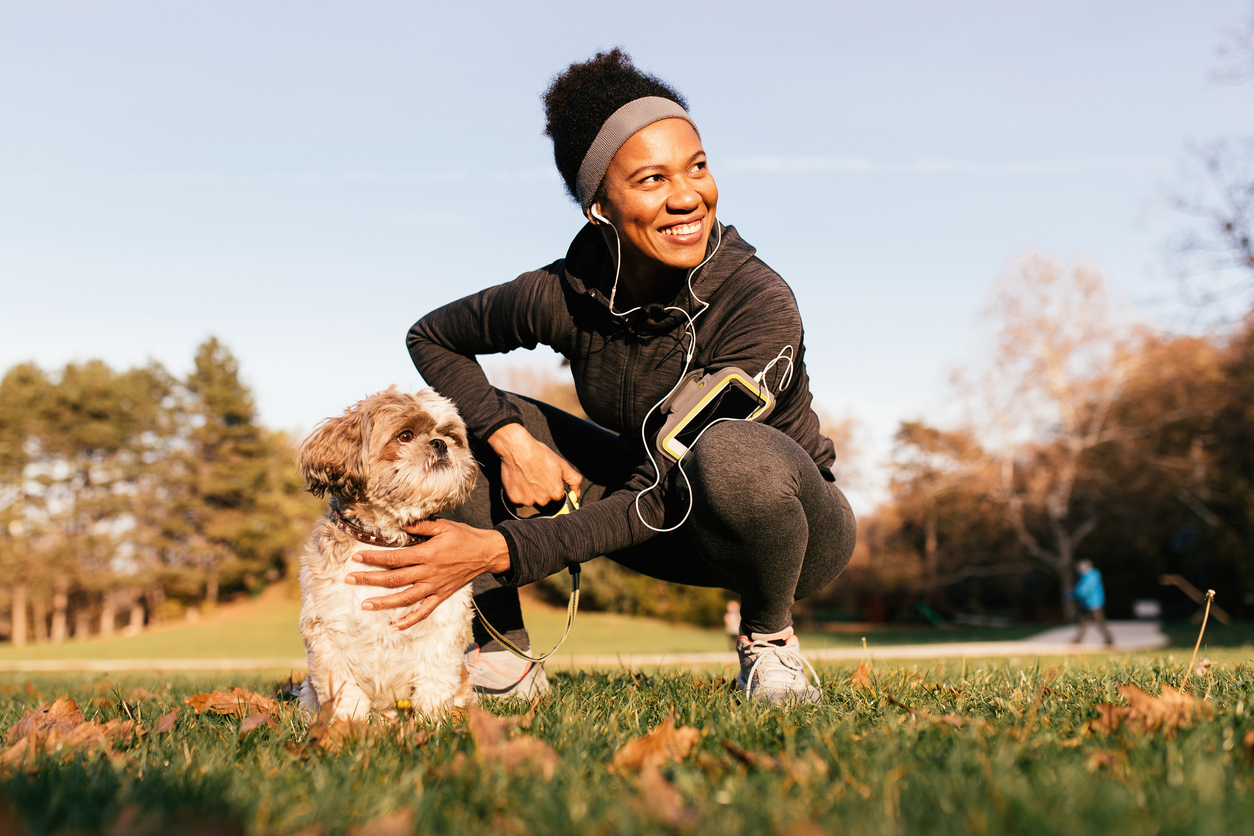Staying active can be a challenge.
Establishing a routine is tough but there’s a furry best mate who can help.
Dogs need regular exercise because it keeps them healthy and social. Dogs need to socialise with other pooches, play and whiff all the smells of the world outside of their home.
Sound familiar?
Okay, maybe not the smell part but we have a lot in common with our pets.
A study found that ‘owning a large dog’ or ‘knowing a dog enjoys going for a walk’ helps keep owners motivated to go for regular walks.
How much exercise does a dog need?
How much exercise a dog needs depends on their age, size and breed. The amount of time can range from 30 minutes – 2 hours per day. Generally, working and herding breeds (Labradors and Collies) need the most exercise, and short-nosed breeds (Bulldog) require less.
A good rule is two 30-minute walks per day combined with activities like playing fetch.
If you’re unsure, it’s good to observe your dog’s behaviour at home. Are they pacing? Are they restless? These are signs that it may be time for exercise. So, it’s time for you to lace up and head out.
Here are ways you can exercise with your dog.
1. Walk
Clocking 10,000 steps per day is a great way to stay active and a study found that dog owners tend to get more steps per day compared to people who do not own a dog:
“The study included 86 adults ages 65 or older, half of whom owned a dog. All the participants wore activity trackers and were monitored continuously for three week-long periods over the course of one year. Dog owners walked an average of 20 more minutes a day and took about 2,700 additional steps compared with people who did not have a dog at home.”
A walk is also great for your mental health because it’s a chance to get out of the house and explore relaxing green spaces like parks and walking trails. While you’re out and about you may also run into family and friends, so it’s an excellent way to stay social.
2. Run
Firstly, check if a dog is a suitable running mate because not all breeds can cope; age and health also factor into the decision. Some breeds like Huskies, Dalmatians, Golden Retrievers and Collies can make fantastic running companions. Plus, consider your own fitness level as running may not be suitable exercise.
Start off slow by taking your dog for a steady jog so you can get used to being running buddies. You’ll also need to be flexible because your dog will want to take breaks to stop and sniff.
The goal is to get your heart rate up while your dog keeps pace. Read your dog’s body language to get a feel for when they’ve had enough. Remember: dogs pant to bring their temperature down so you’ll need to monitor their breathing, so they don’t overexert themselves.
Once you get to know what your dog is like as a running mate you can set a regular routine. There are also other ways your dog can join you for a run if they can’t go the full distance. Get your dog to join you for a few warm up laps around the block and then drop them home before you set off on your usual route.
3. Hike
A hike is a good way to get the blood pumping and destress in natural surroundings but it’s a little more intensive than a casual walk. For dogs, depending on the terrain, a hike can range from moderate to strenuous exercise.
Preparation is key if you want to hike with your dog because not all trails are dog friendly – most national parks in Australia are dog-free zones. You’ll also need to make sure your dog’s vaccinations are up to date because it’s common for dogs to pick up these nasties while in the bush.
Find a trail that allows dogs and a distance that your pup can handle. You’ll need to take plenty of food and water, a leash, poop bags or a trowel and a first-aid kit; cut paw pads are a common injury while hiking.
Enjoy exploring the wilderness with your dog but remember that it’s not all over when you get home. After a hike you must check your dog’s body for ticks, leeches or burrs they may have picked up on the trail.
4. Dog park
If you want to keep it casual and social, try a dog park.
Dog parks are special fenced-off areas where dogs can run and play without a leash.
Dr Susan Hazel, lecturer in animal behaviour, welfare and ethics at the University of Adelaide’s School of Animal and Veterinary Sciences studies the effect on dog parks in communities.
"Dogs that are well socialised and exercised are likely to be healthier, happier and less aggressive,” says Dr Hazel.
“Designated off-leash dog areas provide a safe community setting where dogs can play with each other."
Dr Hazel’s study found that owners too benefit from dog parks.
"We've observed that people get a lot out of using the parks too, not so much with their own exercise but just through the opportunity to meet other people with dogs."
You may not work up a sweat in a dog park, but you will prioritise your mental health because it’s a great social activity.
So, what are you waiting for? Grab your dog and start to get active.


